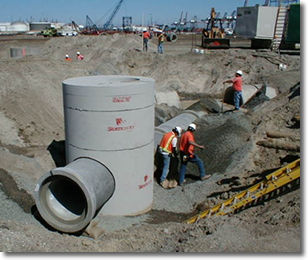Case Study: Stormceptor Assists The Port Of Los Angeles' Berth 100 Wharf And Container Terminal Project San Pedro, CA
 Comprising of 7500 acres and 35 miles of waterfront, the Port of Los Angeles is one of the largest and most diversified seaports in the world. Located in San Pedro Bay, approximately 20 miles from downtown Los Angeles, the Port is America's leading cruise terminal on the west coast and its busiest container port, moving a record breaking 5 million marine cargo containers (TEUs) in November 2001 alone.
Comprising of 7500 acres and 35 miles of waterfront, the Port of Los Angeles is one of the largest and most diversified seaports in the world. Located in San Pedro Bay, approximately 20 miles from downtown Los Angeles, the Port is America's leading cruise terminal on the west coast and its busiest container port, moving a record breaking 5 million marine cargo containers (TEUs) in November 2001 alone.
To enhance the existing terminal's efficiency, the Board of Harbor Commissioners moved ahead with the construction of Berth 100 Wharf and Container Terminal located in the West Basin area of the Port, former home to a Chevron Marine Terminal and Todd Shipyard which closed in the early 1990s. The Wharf portion of the project is currently under construction and will provide the Port with an estimated additional 327,000 TEUS in container capacity.
As the first port authority in the U.S. to establish an Environmental Management Division in 1973, the Port of Los Angeles has become pro-active in the environmental arena over the last several decades. In light of this past history, it was only appropriate that Port engineers, working with their consultant DMJM Harris of Orange, California, made a special effort to pre-treat the storm water runoff from the completed project site prior to it being discharged into the Pacific Ocean. A stringent water quality specification was formulated to ensure that the implemented Structural Best Management Practices (BMPS) would be well tested and proven in their ability to remove a large percentage of the fine sediments and hydrocarbons typically found in storm water runoff. These finer sediments tend to transport nutrients and heavy metals.
Being in a coastal environment, the storm drain outfall pipes operate in a partially submerged condition most of the day so it is critical that the BMPS will still perform in this fluctuating tidal situation.
Stormceptor was subsequently chosen as the preferred BMP to satisfy both the specified treatment and submerged criteria. Each unit is fitted with a special submerged insert to operate under various tidal elevations.
A total of 10 Stormceptor units were manufactured to the highest quality standards at the Los Angeles Plant of Rinker Materials' Hydro Conduit Division in Corona, California and shipped by truck to the project site in San Pedro from May through July 2002.
The installation contractors were Sully Miller of Anaheim, California and Traylor Pacific of Irvine, California.
